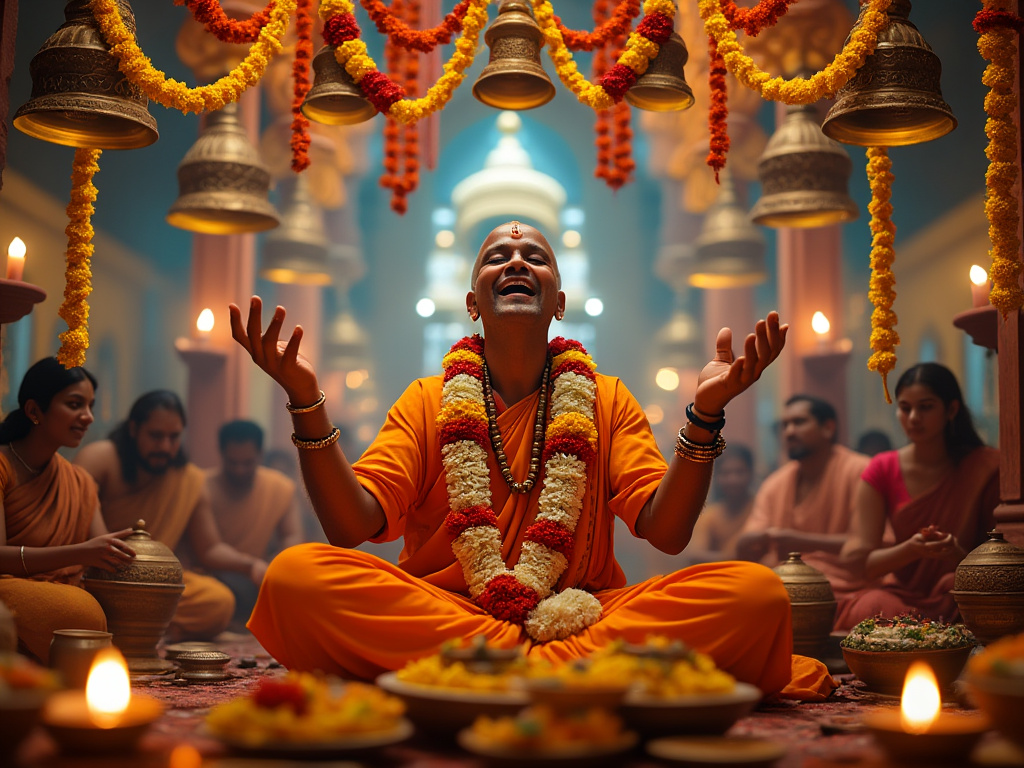


Sanatana Dharma, commonly referred to as Hinduism, is one of the world’s oldest religions, tracing back over 5,000 years in India. The term "Sanatana" means "eternal," and "Dharma" is often translated as "duty," "righteousness," or "the right way of living." Sanatana Dharma, therefore, refers to the "eternal duty" or "universal law" that governs moral and ethical behavior, spiritual practice, and the cosmic order. Rather than a formal religion, it is seen as a way of life, an all-encompassing framework for personal, social, and spiritual harmony.
The history of Sanatana Dharma spans millennia, and it is woven into the fabric of India's cultural and spiritual development. The roots of Sanatana Dharma can be traced back to the Indus Valley Civilization (circa 3300–1300 BCE), and its foundational texts, the Vedas, are thought to have been composed around 1500 BCE. Over time, various other scriptures were written, leading to the diverse and rich philosophical and theological traditions we associate with modern Hinduism.
Sanatana Dharma is significant not only because of its historical influence but also because it provides a framework for understanding the nature of existence, morality, and the divine. It addresses questions such as:
Sanatana Dharma encourages a search for the ultimate truth through various paths such as devotion (Bhakti), knowledge (Jnana), righteous action (Karma), and meditation (Dhyana).
Sanatana Dharma has no single founder or single sacred scripture. Instead, it encompasses various schools of thought and beliefs, but there are core principles common to most traditions:

Sanatana Dharma has a rich corpus of scriptures:
In the daily life of a practitioner, Sanatana Dharma emphasizes a balance of spiritual, personal, and social responsibilities. Key practices include:

Sanatana Dharma has had a profound influence on spiritual, philosophical, and cultural thought globally. Practices such as yoga, meditation, and Ayurveda have gained widespread popularity for their physical and mental health benefits. Philosophical ideas from Sanatana Dharma have influenced global thinkers, including Ralph Waldo Emerson, Carl Jung, and Mahatma Gandhi, promoting ideals of non-violence, personal freedom, and environmental stewardship.
In today’s world, Sanatana Dharma’s emphasis on interconnectedness, respect for all forms of life, and a sustainable way of living has become highly relevant. It encourages harmony with nature, ethical living, and spiritual growth, offering guidance in a world increasingly concerned with climate change, mental health, and social justice.
Albert Einstein (Physicist, Germany)
"When I read the Bhagavad-Gita and reflect about how God created this universe, everything else seems so superfluous."
Mark Twain (Author, USA)
"India is the cradle of the human race, the birthplace of human speech, the mother of history, the grandmother of legend, and the great-grandmother of tradition."
Ralph Waldo Emerson (Philosopher, USA)
"The Vedas are the most inspiring book that has been read in the West."
Henry David Thoreau (Philosopher, USA)
"In the morning, I bathe my intellect in the stupendous and cosmogonal philosophy of the Bhagavad-Gita, in comparison with which our modern world and its literature seem puny and trivial."
Dr. Arnold Joseph Toynbee (Historian, UK)
"It is already becoming clear that a chapter which had a Western beginning will have to have an Indian ending, if it is not to end in the self-destruction of the human race."
Carl Sagan (Astronomer, USA)
"The Hindu religion is the only one of the world’s great faiths dedicated to the idea that the Cosmos itself undergoes an immense, indeed an infinite, number of deaths and rebirths."
Julius Robert Oppenheimer (Physicist, USA)
"The Bhagavad-Gita is the most beautiful philosophical song existing in any known tongue."
Herman Hesse (Nobel Prize-Winning Author, Germany)
"The marvel of the Bhagavad-Gita is its truly beautiful revelation of life’s wisdom which enables philosophy to blossom into religion."
Max Müller (Philologist, Germany)
"The Upanishads are the most wonderful compositions of the human mind, surpassing anything we can imagine."
T. S. Eliot (Poet, UK)
"The great philosophers of India make most of the great European philosophers look like schoolboys."
Sanatana Dharma:
Science:
Example:
The Rig Veda (10:129) speaks of the universe emerging from a void (Sunyata) and later returning to it—a notion comparable to the Big Bang and Big Crunch theories in physics.
Sanatana Dharma:
Science:
Example:
The Hindu cosmological age of one day of Brahma (4.32 billion years) is close to the scientific estimate of Earth’s geological age (around 4.5 billion years).
Sanatana Dharma:
Science:
Example:
The concept of Anu (atom) and Paramanu (sub-atom) mentioned in Vaisheshika philosophy closely parallels the scientific discovery of atoms and subatomic particles like quarks.
Sanatana Dharma:
Science:
Example:
Quantum superposition (where particles exist in multiple states until observed) has similarities with the concept of Maya in Vedanta, where reality is dependent on perception and consciousness.
Sanatana Dharma:
Science:
Example:
Scientific studies show that meditation and breathing techniques (Pranayama) help reduce cortisol levels, lower blood pressure, and improve immunity—outcomes that have been prescribed in Ayurveda for centuries.
Sanatana Dharma:
Science:
Example:
The Rig Vedic description of the speed of light and energy dynamics shows a profound understanding of the universe that is only being comprehended by modern science.
Hindus generally do not engage in proselytization or ask others to join their faith for several reasons rooted in the core philosophy and history of Hinduism. The following are some key aspects explaining this approach:
Hinduism, or Sanatana Dharma, is inherently inclusive and pluralistic. It recognizes multiple paths to spiritual realization and emphasizes the idea that truth can be perceived in different ways. As such, it acknowledges that people have diverse spiritual needs and paths, which do not necessarily have to conform to one religion. The famous Rig Veda verse, “Ekam sat, vipra bahudha vadanti” (Truth is One, but the wise express it in different ways), encapsulates this idea.
Hindus believe in karma (the law of cause and effect) and reincarnation (the cycle of birth and rebirth). According to this worldview, each soul is on its own spiritual journey, progressing at its own pace based on past actions and experiences. Forcing someone to convert would interfere with their natural spiritual progression, which is believed to happen according to their karma.

Unlike some other religions, Hinduism does not have a single prophet or a "one true way" that everyone must follow to attain salvation. The concept of God is also diverse in Hinduism—some sects are monotheistic, some polytheistic, and some even atheistic or non-theistic. The emphasis is on individual spiritual growth and self-realization rather than following a prescribed set of beliefs.
Hinduism places a strong emphasis on inner experience and self-realization. It encourages followers to seek truth through their own experiences, practices like meditation, yoga, and introspection rather than relying solely on dogma or external validation. As such, the religion does not feel the need to convert others or increase numbers.
Historically, Hinduism has not seen itself in opposition to other faiths in a way that would necessitate conversion. It has coexisted with various religions, both indigenous and foreign, without feeling the need to assert its dominance. The lack of a centralized authority or organized structure within Hinduism has also contributed to the absence of a formal missionary tradition.
Hinduism upholds the importance of individual choice and free will. Every individual is considered to be responsible for their own spiritual path. This respect for personal choice makes proselytizing seem unnecessary and even intrusive.
Hinduism is also deeply tied to cultural and social practices that have evolved over millennia in the Indian subcontinent. It is seen more as a way of life rather than just a set of religious beliefs. As a result, the practice of Hinduism is often something people are born into and live out as part of their cultural heritage, making conversion less relevant.
Overall, Hinduism's approach to spirituality is more about personal exploration, respect for diversity of thought, and an understanding of the complex nature of the universe, rather than recruiting followers or increasing numbers.
The impact of Indian laws on Hindu temples is quite distinct when compared to the treatment of other religious shrines, such as churches, mosques, and gurudwaras. The legal and administrative framework governing Hindu temples has been a topic of debate due to the perceived disparity in state control and financial management. The following points outline the major impacts and differences:
Hindu Temples: A significant number of Hindu temples in India are controlled and managed by the state government under the Hindu Religious and Charitable Endowments Act and other similar laws. This means that the administration, revenue, and even decision-making regarding temple funds and rituals are overseen by government-appointed boards or officials. Prominent examples include the Tirupati Temple in Andhra Pradesh and the Sabarimala Temple in Kerala.
Other Religious Institutions: Churches, mosques, and gurudwaras are largely self-governing and free from direct state control. They have their own internal committees or boards that manage their affairs, finances, and properties. This difference arises because these religious institutions are governed by separate laws specific to their communities, such as the Waqf Act for Islamic institutions and the Sikh Gurdwara Act for Sikh gurudwaras.
Hindu Temples: Revenue generated by Hindu temples, including donations from devotees, ticket sales, and other sources, is often subjected to government scrutiny. In many cases, state governments have the authority to divert these funds to purposes that may not be directly related to the temple or even Hindu religious activities. This has led to criticism that temple resources are being used for general welfare projects or even non-Hindu purposes without adequate representation from the Hindu community.
Other Religious Institutions: The funds and resources of churches, mosques, and gurudwaras are typically managed internally. They have greater autonomy in using their finances for religious or community welfare purposes without interference from the state. There are also fewer restrictions on how these funds are utilized, provided they comply with the respective laws governing their operations.
Hindu Temples: State control can extend to property rights as well. In some cases, temple lands and properties have been taken over by the state, and the proceeds from the sale or lease of these properties are often not fully reinvested in the temples themselves. This affects the autonomy of temples in managing their assets and has led to allegations of mismanagement and corruption.
Other Religious Institutions: Religious shrines like mosques and churches are usually able to retain control over their properties and assets. The Waqf Board, for example, administers Islamic properties, but it does so with representatives from the Muslim community, providing a higher degree of community-based governance.
Hindu Temples: The appointment of priests and temple administration is sometimes subject to government regulation. In some states, the government has the power to appoint priests or trustees, potentially leading to interference in religious practices and customs. This practice has been criticized as it undermines traditional practices and the authority of the temple communities.
Other Religious Institutions: Churches and mosques generally have the freedom to appoint their own religious leaders without external interference. For instance, the Catholic Church appoints its own priests through its internal hierarchy, and mosques select their imams through community consensus.
Hindu Temples: Hindu temples are often subject to various forms of taxation, including income tax on certain revenues, property tax, and other levies. Despite being religious institutions, they may not receive the same exemptions or benefits that are extended to other religious bodies.
Other Religious Institutions: Many churches, mosques, and other religious institutions enjoy broader tax exemptions and benefits under the law. These institutions are often classified as charitable organizations, providing them with significant financial leeway in their operations.
Hindu Temples: When disputes arise or temples seek legal recourse against government interference, the process can be prolonged and complicated. Community representation in decision-making bodies is often limited, making it difficult for Hindu communities to reclaim administrative control.
Other Religious Institutions: Religious institutions like churches and mosques generally have established legal bodies and community representation that can advocate on their behalf. This ensures a stronger voice in legal and administrative matters.
Overall, while the Indian Constitution provides for the equal treatment of all religions, the actual implementation in the context of temple management shows considerable disparity. The impact of these laws on Hindu temples remains a topic of debate and ongoing reform efforts.
Government control over Hindu temples in India has been a contentious issue due to perceived inequalities in how temples are managed compared to other religious institutions. There are numerous examples where state governments exercise control over temple administration, finances, and even religious practices. Here are some notable instances:
In a rapidly globalizing world, there is a risk of losing unique cultural identities. Sanatana Dharma helps Hindus remain connected to their spiritual roots while balancing modern demands. This balance fosters a sense of belonging and purpose amid a fast-paced, homogenizing world.
With moral ambiguity growing in personal, societal, and professional realms, the teachings of dharma offer clear principles of righteousness, integrity, and fairness. By adhering to these ethical guidelines, individuals and communities can promote justice and trust.
Sanatana Dharma’s reverence for nature and all living beings aligns with modern environmentalism. Worshipping nature as sacred helps to foster an attitude of stewardship and ecological balance—an urgent need in the face of global environmental crises.
The spiritual practices embedded in Sanatana Dharma, such as meditation, yoga, and selfless service, provide tools for managing stress and maintaining emotional health. These methods offer holistic approaches to mental well-being, which are increasingly important in today’s high-pressure environments.
Sanatana Dharma’s inclusive teachings, such as “Ekam Sat, Vipra Bahudha Vadanti” (Truth is One, but sages call it by many names), promote pluralism and respect for all religions. This philosophy can act as a bridge in a polarized world, encouraging harmony and tolerance across faiths and cultures.
The wisdom found in texts like the Upanishads and the Bhagavad Gita encourages intellectual growth, self-exploration, and spiritual transformation. By engaging with these teachings, individuals can gain a deeper understanding of life’s purpose and pursue truth beyond the material.
The focus on family values and community life in Sanatana Dharma helps promote social stability and strong relationships. These principles foster respect for elders, responsibility toward the family, and harmony within society, which are increasingly vital as traditional structures evolve.
Ayurveda, deeply rooted in Sanatana Dharma, emphasizes preventive care and lifestyle balance. Its holistic approach to health, integrating diet, mind-body wellness, and natural remedies, offers an alternative to increasingly commercialized healthcare systems.
Sanatana Dharma provides a long-term spiritual goal—moksha, or liberation from the cycle of rebirth. By focusing on karma and reincarnation, it shifts attention from materialism to spiritual growth, reminding individuals to seek fulfillment beyond temporary worldly success.
Temples, festivals, and religious institutions play a vital role in maintaining cultural heritage. Sanatana Dharma ensures that these institutions continue to flourish, serving as centers for spiritual education and cultural continuity for future generations.
Yoga, meditation, and the principles of Sanatana Dharma have gained global acceptance and respect. These practices enhance India’s cultural influence and soft power, positioning Hindus as global ambassadors of spirituality, mental well-being, and peace.
The emphasis on simple living and high thinking in Sanatana Dharma serves as a counter-narrative to materialism. By prioritizing inner peace and spiritual growth over wealth accumulation, it offers a pathway to contentment and purpose beyond consumer-driven values.
The principles of selfless service, moral conduct, and civic duty embedded in Sanatana Dharma can contribute to the creation of a more ethical and compassionate society. As India modernizes, these values provide a strong foundation for sustainable nation-building.
Sanatana Dharma’s flexible approach allows for various spiritual paths—devotion, knowledge, service, or meditation—giving individuals the freedom to follow a practice suited to their temperament and lifestyle. This inclusiveness resonates with modern seekers who value personal spiritual autonomy.
Sanatana Dharma’s teachings on universal love, non-violence, and respect for all religious traditions promote global peace and interfaith dialogue. In a world marked by increasing division, these values offer a model for harmonious coexistence and mutual understanding.
Allowing spiritual and community leaders, rather than government officials, to manage temples ensures that decisions are guided by dharmic principles. This preserves the sanctity, purpose, and spiritual focus of temples, allowing them to serve as true centers of worship and learning.
Autonomy safeguards the continuity of ancient rituals, customs, and practices from external interference. It ensures that traditions passed down through generations remain intact and are not altered by outside influences that may not understand their spiritual significance.
Ensuring that temple revenues are used for religious, educational, and charitable activities—rather than being diverted for unrelated purposes—aligns with dharmic principles. It allows temples to support their communities, uphold religious traditions, and contribute positively to society.
A centralized board can provide clear guidelines, oversight, and accountability for temple operations, ensuring transparency in management and financial matters. This builds trust within the community and ensures that resources are used ethically and effectively.
Temples, as centers of learning, can promote the teachings of Sanatana Dharma, fostering spiritual growth. Offering classes and programs on dharmic teachings helps spread knowledge of scriptures, ethics, and philosophy to the wider community, ensuring the next generation is connected to their cultural and spiritual roots.
Ensuring that temple funds are directed toward the maintenance and development of infrastructure improves the experience for pilgrims and worshipers. It also helps preserve ancient heritage sites, ensuring they remain accessible and well-maintained for future generations.
Temples have traditionally been centers of charitable activity, offering services like feeding the poor (anna-danam), educational support, healthcare, and other welfare initiatives. With proper management, these activities can be expanded, contributing to the social upliftment of surrounding communities.
Temple management plays a crucial role in reviving and sustaining local festivals, arts, and cultural practices that might otherwise fade due to neglect or lack of resources. Temples become focal points for preserving and promoting local traditions and performing arts.
By ensuring fair wages and working conditions for temple priests, staff, and workers, temples can support those who dedicate their lives to the service of the divine. This not only improves the livelihoods of those working within temple institutions but also ensures that the workforce is motivated and respected.
Encouraging local community involvement fosters a sense of ownership and participation in temple activities. It strengthens the connection between temples and their surrounding communities, enhancing spiritual life and cultural identity for all involved.
Ensuring that temple lands and assets are protected from sale or misappropriation is crucial for preserving the spiritual and cultural heritage of future generations. Temple properties, historically, have been sources of social and economic support for communities, and their integrity must be maintained.
By supporting the development of pilgrimage tourism, temples can contribute to both the local economy and spiritual tourism. This promotes religious tourism, cultural exchange, and economic growth in regions with historic and spiritually significant temples.
Ensuring that Hindus can manage their religious institutions without government interference is a key aspect of religious freedom. Temples should have the right to operate according to their spiritual traditions, which is essential for maintaining their role as religious, cultural, and community centers.
Sanatana Dharma, with its inclusive, spiritual, and philosophical foundations, continues to be relevant today. By understanding its principles, promoting the autonomy of Hindu temples, and educating the masses about the timeless wisdom of this ancient tradition, we can preserve its heritage for future generations. Hindus should work toward establishing Sanatana Dharma Boards to ensure that their temples remain centers of spirituality and learning.
This is not meant to blame or criticize any other religion or community. It is a call to safeguard the spiritual and cultural heritage of Sanatana Dharma. Let us spread awareness about this important issue in a positive and constructive manner.